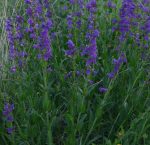 Rocky Mountain beard-tongue is a semi evergreen perennial native to western US from southern Wyoming and western Colorado to northeastern Arizona and northern New Mexico, with an isolated population in east central California where it grows with sagebrush and in meadows, slopes, and open areas of woodlands and forests. It is a member of the plantain family, Plantaginaceae, that also includes snapdragon, turtlehead, and foxglove. With a fibrous root system plants grow 1-3′ tall and form a dense mat of foliage with several stems. The leaves are long and narrow with the basal ones being longer than those on the stems. In spring, spikes of royal blue to purple flowers .75-1.50″ long rise above the mat of foliage. The tubular flowers are two lipped; the upper lip is two lobed and projects over the lower, three-lobed lip. Butterflies and beneficial insects find the flowers attractive. Plants are valued as ornamentals for the garden and are especially good in dry areas of the country. The genus name, Penstemon, comes from the Greek words pente meaning five and stamon meaning the warp of an upright loom, and refers to the five thread-like pollen bearing organs of the flower that stand upright. The specific epithet, stricta, is the Latin word meaning tight or close.
Rocky Mountain beard-tongue is a semi evergreen perennial native to western US from southern Wyoming and western Colorado to northeastern Arizona and northern New Mexico, with an isolated population in east central California where it grows with sagebrush and in meadows, slopes, and open areas of woodlands and forests. It is a member of the plantain family, Plantaginaceae, that also includes snapdragon, turtlehead, and foxglove. With a fibrous root system plants grow 1-3′ tall and form a dense mat of foliage with several stems. The leaves are long and narrow with the basal ones being longer than those on the stems. In spring, spikes of royal blue to purple flowers .75-1.50″ long rise above the mat of foliage. The tubular flowers are two lipped; the upper lip is two lobed and projects over the lower, three-lobed lip. Butterflies and beneficial insects find the flowers attractive. Plants are valued as ornamentals for the garden and are especially good in dry areas of the country. The genus name, Penstemon, comes from the Greek words pente meaning five and stamon meaning the warp of an upright loom, and refers to the five thread-like pollen bearing organs of the flower that stand upright. The specific epithet, stricta, is the Latin word meaning tight or close.
Type: Semi-evergreen perennial
Bloom: Spikes of tubular two lipped royal blue to purple flowers in spring
Size: 2-3′ H x .5-1′ W
Light:Full sun but tolerates light shade
Soil: Average, medium moist to dry, well-drained; drought tolerant
Hardiness: Zones 3-8
Care: Cut back stems after flowering to level of foliage mat.
Pests and Diseases: Aphids, grasshoppers, penstemon weevil, slugs, snails, root rot, powdery mildew, leaf spot, rust, blight
Propagation: Seed, division in spring, softwood cuttings in early summer, semi-ripe cuttings in midsummer
Companion Plants: Paintbrush, evening primrose, purple poppy mallow, narrow leaf coneflower
Outstanding Selections: ‘Bandera’